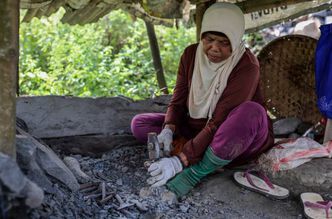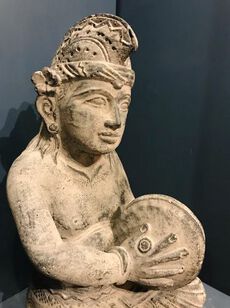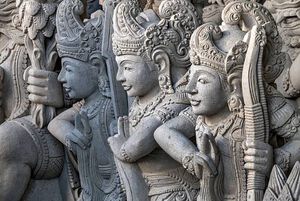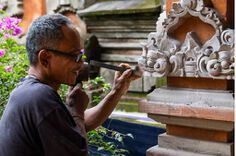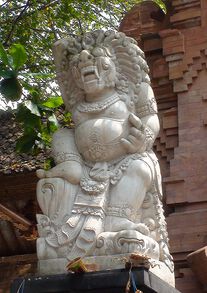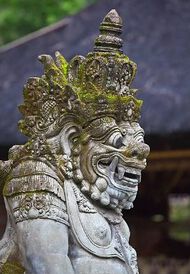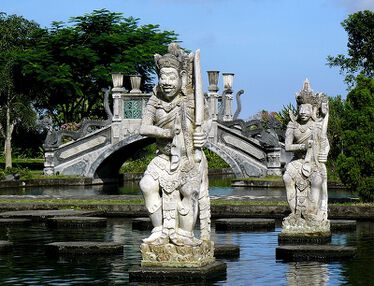Stone Carvings
To create a new page, enter a unique page name below.
If a page with that name already exists, you will be sent to a form to edit that page.
For existing pages ... see category Stone Carvings.
Fill in the form with the details of your image and save the page.
The Mastercraft Of Stone Sculpture
Carving in stone and wood are particularly rich. Stone sculptures of the elaborate Hindu variety in Java or the ornate sarcophagi of Sumatra are archaeological remains of value, but only in Bali is elaborate stone carving still done (apart from that which may decorate some upscale Jakarta homes or public buildings). Volcanic rock are carved to create statues depicting characters from ancient Indonesian myths and epics. These Stone Carvings are predominantly found in Yogyakarta and Bali where stone carving traditions date back over 900 years and were highly developed during the construction of major temples in these areas.
Unique carved lava stone musician figures from Merapi in Central Java are created from the Lava stone from Mount Merapi, an active volcano in Central Java. Carved in the foothills of the mountain, near to the ancient temple of Borobudur, each one is unique.
Stone sculpture is a newer form of sculpture in Bali, flourishing in the 8th to 10th Century. Most of the stone sculptures found on the island are influenced by the religious traditions of Hinduism and Buddhism. These gorgeous stone sculptures are most often found at ancient temples but on the right hiking trail, you can stumble across standalone pieces. Most of the stone sculptures are created with an ashy, grey sandstone quarried from the banks of the many rivers that run through the island. Balinese believe strongly in maintaining their temples, so sculpture is more than just an artform, but also it is a deeply profound religious practice. If you travel to Batubalan or Karang, you can see the master stone carvers at work and observe the great skill and meditative practice of these ancient artisans.
The long and storied tradition of Indonesian sculpture captures the imagination of anyone who visits the island of Bali. Dotted among the volcanic mountains, thick jungles, and iconic rice paddies are wooden and stone sculptures of animals, deities, and ancestral heroes. These sculptures are the work of both ancient and modern artisans and add to the magical feeling of the island. Every tribe has a unique sculptural style and every statue tells a unique story. In Bali, you can see the full range of diverse styles of sculpture and may even find an exotic piece to take home as a souvenir of your journey.
Culture Of Balinese Sculpture
The long and storied tradition of Indonesian sculpture captures the imagination of anyone who visits the island of Bali. Dotted among the volcanic mountains, thick jungles, and iconic rice paddies are wooden and stone sculptures of animals, deities, and ancestral heroes. These sculptures are the work of both ancient and modern artisans and add to the magical feeling of the island. Every tribe has a unique sculptural style and every statue tells a unique story. In Bali, you can see the full range of diverse styles of sculpture and may even find an exotic piece to take home as a souvenir of your journey.
The hamlet of Batubulan, located in the midst of Denpasar and Ubud, is the hub of stone carving. Almost every Balinese home is done up with sculptures at the entrance that mostly depict demons. There was a time when the stone carvers of Ubud would create works to embellish temples and palace getaways. While strolling on the streets of Ubud, I came across a wide array of sculptures that have been skillfully carved from sandstones and appear quite heavy. Balinese sculptors use soft black volcanic rocks and white palimanan soft stone for carving.
The tradition of stone carving in Bali dates back to the times of the Majapahit dynasty, the largest kingdom that ruled Southeast Asia, and it was the Hindu empire that ruled over Java and established stronghold in Bali way back in 14th century.
Be it Buddha, Ganesha, Garuda, Shiva, giant frogs, monkeys, demons and other Hindu gods, one can find them all in Ubud. Another interesting piece of stone work is the human palm. Price-conscious tourists can go for a good bargain, and get sculptures at a wallet-friendly price.
While walking down the Ubud countryside, there are a wide collection of stone carvings that are on display on the narrow paths in the midst of lush paddy fields. These stone sculptures are cheaper than in the interiors of Ubud. In the downtown area of Ubud in Subak Sok Wayah around 20 minutes away, there are restaurants dishing up organic food for travellers and the name of the food outlet is also carved and painted on stone.
More info:
The art of stone carving
The buddhist bas reliefs of borobudur
Borobudur Temple compounds
Understanding the thousands of relief-panels of borobudur
